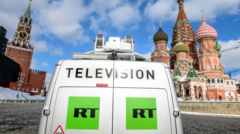The second apparent assassination attempt against former President Donald Trump in just over two months involved a gunman who had previously said he was willing to fight and die in Ukraine. This underscores how that war is not just influencing American politics and foreign policy but also having an impact on the nation’s social fabric.
As one issue that divides Americans along party lines, the war has helped harden political polarization in American society.
According to one survey, 66 percent of Republicans would like the U.S. to encourage Kyiv to negotiate with Moscow, whereas the bulk of Democrats (62 percent) favor supporting Ukraine for as long as it takes. The partisan divide in foreign policy extends even to perceptions of which country represents America’s main adversary: Republicans are most concerned about China, whereas Democrats worry about Russia above all.
As part of President Joe Biden’s strategy to bleed Russia in Ukraine, the U.S. has played a critical role in bankrolling the Ukrainian fight against the invading Russian forces, with Congress approving almost $175 billion in military and nondefense assistance. But American assistance has been unable to turn the tide in the war, with Russia still making slow but steady territorial gains in eastern Ukraine.
One key reason is that, more than weapons and funds, Ukraine needs new recruits to replenish the ranks of its exhausted and depleted forces. But even draconian conscription practices have not been able to offset its mounting troop shortfall.
The war, meanwhile, has exposed some Western military shortcomings, including America’s inadequate industrial capacity to restock weapons and critical munitions depleted in supplying Ukraine.
The war also carries hidden costs, including inflation at home. A survey found that 49 percent of Americans support negotiations between Ukraine and Russia so that costs for U.S. households do not increase further.
The U.S. dollar, which was facing “stealth erosion” before the Ukraine war, now confronts a more open but nascent challenge to its global dominance in response to the West’s weaponization of finance and seizure of Russia’s earnings on its central-bank assets frozen by Western governments. As countries explore alternatives to the dollar, the greenback is beginning to lose some of its global influence, especially in oil markets.
Meanwhile, as a hedging strategy, central banks in many countries — especially China, Turkey, India, Kazakhstan and in Eastern Europe — have increasingly been buying gold. Such hoarding, coupled with greater geopolitical uncertainty, has helped drive gold prices to a record high.
The Ukraine war’s hidden costs also extend to the geopolitical realm, especially by hindering the ability of the U.S. to respond to the greater challenge it faces from China.
China poses a far greater threat than Russia to Western interests and the U.S.-led world order. Whereas Russia’s designs are largely confined to its neighborhood, China is seeking to supplant the U.S. as the world’s foremost power. It also has the means: China’s economy, like its population, is about 10 times larger than Russia’s, and China spends four times as much as Russia on its military.
Furthermore, China is currently engaged in the largest peacetime military buildup in history. It has more than doubled its nuclear-weapons arsenal since 2020 and is expanding its conventional forces faster than any other country since World War II.
The last thing Chinese President Xi Jinping wants is an end to the Ukraine war, because that would leave the U.S. free to focus on the Indo-Pacific, a critical region that will shape the next global order. China’s expansionism is centered in the Indo-Pacific, from the East and South China Seas, to the Taiwan Strait, to the Himalayas.
The U.S. is dedicating insufficient attention and resources to countering Chinese expansionism and also continues to inadvertently bolster China’s global influence, not least through its overuse of sanctions against a host of countries.
With its military resources already stretched thin by its involvement in the wars in Ukraine and the Middle East, the U.S. needs a more realistic balancing of its key geopolitical objectives at a time when a majority of Americans believe that the nation’s power is declining on the world stage. Without such rebalancing, the U.S. may well fail to deter China from attacking Taiwan or cementing a strategic axis with Russia, just as Biden failed to deter Russia from invading Ukraine.
The U.S. must face up to the reality that, despite substantial Western military assistance, Kyiv is in no position to oust Russia from the territories it has occupied in Ukraine’s east and south. Letting Ukraine use long-range Western cruise missiles to strike targets deep inside Russia with U.S. navigational data and other technology would only risk a direct NATO-Russia conflict.
More fundamentally, a protracted Ukraine war is not in America’s interest. But bringing an end to the war demands dialogue and diplomacy, which Biden has shunned with Moscow.
Amid heightened U.S.-Russia tensions, Indian Prime Minister Narendra Modi has sought to broker a cease-fire. After his visits to Moscow and Kyiv, Modi will brief Biden on his peacemaking effort when they meet at the Sept. 21 Quad summit in Wilmington, Del. Without full support from the U.S., Modi — who is scheduled to meet with Russian President Vladimir Putin again next month at a BRICS leaders’ summit — can achieve little.
A possible American policy shift in favor of a cease-fire may have to await the outcome of the November election. Given that a negotiated deal is the only way to halt the war, it is better to seek it sooner rather than after months or years of more bloodshed and devastation.
Brahma Chellaney is a geostrategist and the author of nine books, including the award-winning “Water: Asia’s New Battleground.”















 English (US) ·
English (US) ·